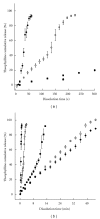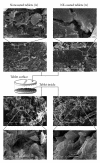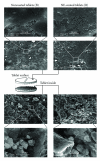A new application of lipid nanoemulsions as coating agent, providing zero-order hydrophilic drug release from tablets
- PMID: 22272376
- PMCID: PMC3261482
- DOI: 10.1155/2012/271319
A new application of lipid nanoemulsions as coating agent, providing zero-order hydrophilic drug release from tablets
Abstract
The objective of the present investigation was to evaluate potential of nanoemulsions as a coating material for the tablets. The nanoemulsion of size less than 100 nm was prepared using a simple and low-energy spontaneous emulsification method. Conventional tablets containing theophylline as a model hydrophilic drug were prepared. The theophylline tablets were coated with the nanoemulsion using a fluid bed coater. The effect of different levels of the nanoemulsion coating on the theophylline release was evaluated. The theophylline tablets containing different levels of the nanoemulsion coating could be successfully prepared. Interestingly, the coating of tablet with the nanoemulsion resulted in zero-order release of theophylline from the tablets. The noncoated theophylline tablets release the entire drug in less than 2 minutes, whereas nanoemulsion coating delayed the release of theophylline from tablets. This investigation establishes the proof of concept for the potential of nanoemulsions as a coating material for tablets.
Figures






Similar articles
-
Silk fibroin as a novel coating material for controlled release of theophylline.Eur J Pharm Biopharm. 2005 Aug;60(3):373-81. doi: 10.1016/j.ejpb.2005.02.002. Eur J Pharm Biopharm. 2005. PMID: 15996578
-
Preparation of delayed release tablet dosage forms by compression coating: effect of coating material on theophylline release.Pharm Dev Technol. 2010 Jun;15(3):305-10. doi: 10.3109/10837450903188519. Pharm Dev Technol. 2010. PMID: 22716471
-
Formulation and characterization of a compacted multiparticulate system for modified release of water-soluble drugs--Part II theophylline and cimetidine.Drug Dev Ind Pharm. 2009 May;35(5):568-82. doi: 10.1080/03639040802459460. Drug Dev Ind Pharm. 2009. PMID: 18979306
-
Evaluating the effect of coating equipment on tablet film quality using terahertz pulsed imaging.Eur J Pharm Biopharm. 2013 Nov;85(3 Pt B):1095-102. doi: 10.1016/j.ejpb.2013.03.019. Epub 2013 Apr 4. Eur J Pharm Biopharm. 2013. PMID: 23563103
-
Film-coated matrix mini-tablets for the extended release of a water-soluble drug.Drug Dev Ind Pharm. 2015 Apr;41(4):623-30. doi: 10.3109/03639045.2014.891128. Epub 2014 Feb 24. Drug Dev Ind Pharm. 2015. PMID: 24564797
Cited by
-
Green Synthesis of Blumea balsamifera Oil Nanoemulsions Stabilized by Natural Emulsifiers and Its Effect on Wound Healing.Molecules. 2024 Apr 26;29(9):1994. doi: 10.3390/molecules29091994. Molecules. 2024. PMID: 38731484 Free PMC article.
-
Effect of coated organic acids on growth performance, Clostridium perfringens colonization, gut integrity and immune response in broilers challenged with subclinical necrotic enteritis.Poult Sci. 2025 Jun 28;104(10):105504. doi: 10.1016/j.psj.2025.105504. Online ahead of print. Poult Sci. 2025. PMID: 40628145 Free PMC article.
References
-
- Kim CJ, Lee PI. Hydrophobic anionic gel beads for swelling-controlled drug delivery. Pharmaceutical Research. 1992;9(2):195–199. - PubMed
-
- Langer R. Drug delivery and targeting. Nature. 1998;392(6679):5–10. - PubMed
-
- Lee B, Ryu S, Cui J. Controlled release of dual drug-loaded hydroxypropyl methylcellulose matrix tablet using drug-containing polymeric coatings. International Journal of Pharmaceutics. 1999;188:71–80. - PubMed
-
- Torchilin VP. Structure and design of polymeric surfactant-based drug delivery systems. Journal of Controlled Release. 2001;73(2-3):137–172. - PubMed
-
- Lecomte F, Siepmann J, Walther M, MacRae RJ, Bodmeier R. Blends of enteric and GIT-insoluble polymers used for film coating: physicochemical characterization and drug release patterns. Journal of Controlled Release. 2003;89(3):457–471. - PubMed
LinkOut - more resources
Full Text Sources

